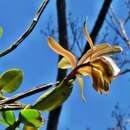Biology
provided by Arkive
Typically Cattleya forbesii grows as an epiphyte on trees and shrubs, but close to the sea, it also grows on rocks (2) (3). Flowering occurs over spring and summer, with a peak between April and July. The colourful veining on the inside of the lip attracts the insect pollinators, which, in accessing the nectar, transfer the pollen from the stamens of one flower to the stigma of another (2).
Conservation
provided by Arkive
Cattleya forbesii is listed under Appendix II of CITES which makes it an offence to trade this species without a permit (1).
Description
provided by Arkive
With its pale coloured flowers, Cattleya forbesii is considered to be one of the least showy species in the classically flamboyant orchid genus, Cattleya (2) (3). The colour of the sepals and the petals vary from light yellow-green to pinkish-tan, while the outside of the comparatively short, frilly-edged lip, is usually white (2). Internally the lip is pale yellow, with a central yellow stripe and pinkish veins (2) (4). The thin stems have two leathery, oblong leaves (4).
Habitat
provided by Arkive
Found in coastal swamps and forests (3).
Range
provided by Arkive
Cattleya forbesii is very common along the coast of southern Brazil, from the state of Rio de Janeiro to the state of Santa Catarina (2) (3).
Status
provided by Arkive
Listed on Appendix II of CITES (1).
Threats
provided by Arkive
Although domestic trade in Brazil has contributed significantly to the scarcity of several coastal forest orchid species (1), Cattleya forbesii remains extremely common in parts of its range (3). Furthermore, as Cattleya forbesii grows easily in cultivation (2) (3), wild plants are unlikely to be heavily exploited.
Cattleya forbesii
provided by wikipedia EN
Cattleya forbesii, or Forbes' cattleya, is a species of orchid. The diploid chromosome number of C. forbesii has been determined as 2n = 54–60.[1]
References

- license
- cc-by-sa-3.0
- copyright
- Wikipedia authors and editors
Cattleya forbesii: Brief Summary
provided by wikipedia EN
Cattleya forbesii, or Forbes' cattleya, is a species of orchid. The diploid chromosome number of C. forbesii has been determined as 2n = 54–60.
- license
- cc-by-sa-3.0
- copyright
- Wikipedia authors and editors

